Share
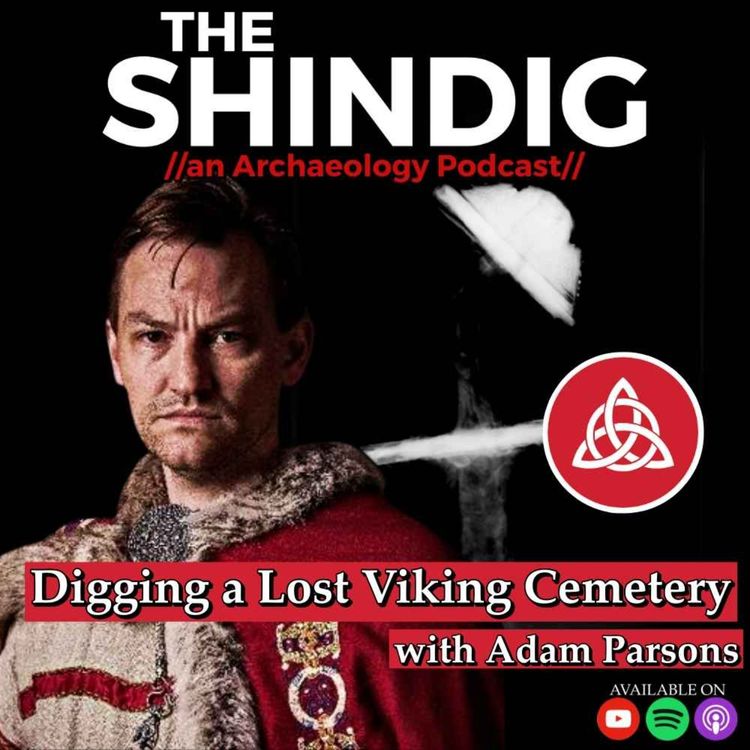
The Shindig - An Archaeology Podcast
Digging a Lost Viking Cemetery – with Adam Parsons
A Viking Cemetery in northern England: Adam Parsons of Oxford Archaeology tells us about the spectacular Cumwhitton Viking cemetery in Cumbria, subject of the brilliant ‘Shadows in the Sand: Excavation of a Viking-age Cemetery at Cumwhitton’, which Adam co-authored.
Initially discovered by metal detectorists Peter Adams and George when they found two Viking-style oval brooches, Oxford Archaeology excavated what turned out to be one of the most spectacular and important Viking cemeteries ever found in Britain. The seven furnished graves contained a truly remarkable selection of grave goods, including the remains of a wooden box containing shears, needles and a glass slickstone for smoothing fabric, with other graves containing items like amber beads, pins, silver rings, swords, axes, spears, spurs/buckles, and rare evidence for rugs and textiles. While few bones remained in the sandy soil, the burial items at Cumwhitton tell us of a society rich both in material culture but also in the cross-cultural contacts and borrowings that made Viking-Age Cumbria such a remarkable place.
From Cumwhitton, we move across Cumbria to Workington and the discovery of a huge early medieval cemetery under the burnt-out remains of St. Michael’s church. Excavated by Carlisle Archaeology, Adam and his colleagues completed the post-excavation work and wrote up the report on the amazing early medieval carved stones, inclusive of fragments of a newly-discovered ‘hogback’ stone, and multiple cemeteries, which include a mid-to-late 9th century grave with strong parallels to the Viking burials at Cumwhitton, underneath St. Michael’s.
With a focus on the northern Britons, we end with a fascinating discussion on the new multicultural world that was carved out in Cumbria and its surrounding regions in the Viking Age.
Adam Parsons is a brilliant archaeological illustrator, writer and editor with Oxford Archaeology who has worked in archaeology for over 20 years. What's more, he has devoted his spare time to being brilliant at early medieval public outreach, making exact reproductions of historical artefacts for museums, universities, and individuals and being part of Cumbraland, a living history group dedicated to portraying the 9th-11th century Brittonic Kingdom of Strathclyde. Adam is no stranger to online outreach, having large followings across his Blueaxe Reproductions social media channels on Facebook, Twitter, YouTube, and more!
Prof. Fiona Edmonds
Gaelic Influence in the Northumbrian Kingdom: The Golden Age and the Viking Age
Edmonds, F. 15/12/2019 Woodbridge : Boydell & Brewer. 322 p. ISBN: 9781783273362. Electronic ISBN: 9781787445864.
The expansion of the Kingdom of Strathclyde
Edmonds, F. 1/02/2015 In: Early Medieval Europe. 23, 1, p. 43-88. 46 p.
Prof. Stephen Driscoll
Driscoll, S.T. (2014) The Govan Stones. History Scotland, 14(1), pp. 36-37.
Dalglish, C., Driscoll, S.T. , Maver, I., Shead, N.F. and Shearer, I. (2009) Historic Govan: Archaeology and Development. Series: The Scottish burgh survey. Historic Scotland: Edinburgh, UK. ISBN 9781902771625
Driscoll, S.T. (1998) Church archaeology in Glasgow and the kingdom of Strathclyde. Innes Review, 49(2), pp. 95-114.
Cynthia Thickpenny
Thickpenny, Cynthia Rose (2019) Making key pattern in Insular art: AD 600-1100. PhD thesis, University of Glasgow. https://theses.gla.ac.uk/41009/
More episodes
View all episodes
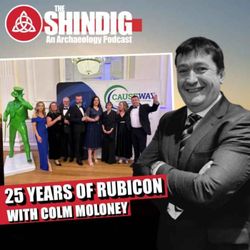
25 Years of Rubicon with Colm Moloney
32:51|🎙️ The Shindig: A Special Interview with Colm MoloneyIn this special edition of The Shindig, host Luke Barry sits down with Colum Moloney, founder of Rubicon Archaeology, to celebrate the company’s 25th anniversary. Thought lost to a corrupted hard drive, this insightful interview was recovered and now serves as a time capsule of Rubicon’s journey from humble beginnings to international expansion.Colm shares his personal story, from discovering his passion for archaeology and history in primary school to founding one of Ireland’s leading archaeological firms. He reflects on the challenges of fieldwork, the evolution of commercial archaeology, and the excitement of managing large-scale infrastructure projects across Ireland, the UK, and Germany.We also explore Rubicon’s recent rebrand, the launch of new offices, and the company’s role in Europe’s largest civil engineering project, SuedLink. With anecdotes, advice for aspiring archaeologists, and a touch of nostalgia, this episode is a must-listen for anyone curious about the past and the future of archaeology.🔗 Learn more at rubiconarchaeology.com📧 Contact: info@rubiconheritage.com📍 Follow us on social media @RubiconArchaeology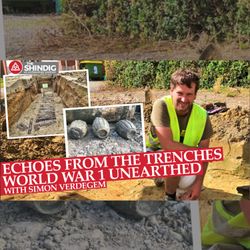
Echoes from the Trenches: WW1 Unearthed – with Simon Verdegem
01:38:09|The incredibly well preserved WW1 trenches and battlefields of Flanders fields on the Western Front are the focus of this remarkable interview with Simon Verdegem, a battlefield archaeologist for BAAC Vlaanderen, Skylarcs, and Head Archaeologist for Dig Hill 80, an internationally crowdfunded WW1 battlefield archaeology project. Join Dr. Tom and Luke as they investigate the fascinating and haunting world of World War I archaeology with Simon, an expert in uncovering the stories of soldiers on the Western Front. In this episode, we explore the impact of trench warfare on the combatants, the emotional toll of excavating battlefields and their dead, and the remarkable discoveries that shed light on the daily lives of soldiers. Simon shares his insights on trench construction and its evolution and the incredible preservation of archaeological finds, from the trenches, tunnels and bunkers that look little changed since 1918, to the harrowing remains of a soldier’s cuddly toy. We also discuss the dangers of unexploded ordnance (UXO), the vital but traumatic journey of identifying fallen soldiers, and the international success of crowdfunding Dig Hill 80, an astonishingly intact battlefield at Wytschaete near Ypres. #WW1 #FWW #Archaeology #History #WesternFront #FirstWorldWar #WorldWar1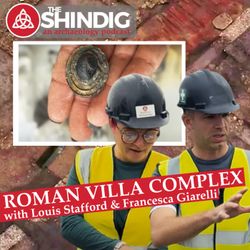
Roman Villa Complex with Francesca Giarelli & Louis Stafford
01:03:50|In this episode, Dr. Tom and Luke dive into the rich history of the Brookside Meadows Roman villa complex! From Bronze Age and Iron Age activity to not one, but two Roman villas and rare evidence for potential early medieval life, Red River Archaeology Group Site Director Francesca Giarelli and Project Manager Louis Stafford uncover the site's evolution and the significance of an area being developed for housing by Barratt and David Wilson Homes. Explore the intriguing evidence of cult activities at a possible shrine or temple, the wealth of Roman artefacts that includes one of the most remarkable assemblage of painted wall plaster yet discovered in Roman England, and the fascinating challenges of identifying post-Roman activity. Hear about the team's dedication, the project's impact on the local community, and the global interest it has garnered. Join us for a captivating journey through time and archaeology! #Roman #Romans #archaeology #history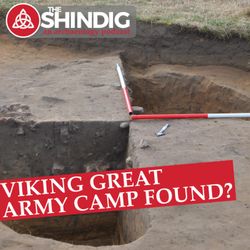
A Lost Anglo-Saxon Estate and the Viking Great Army
01:37:02|A sensational early medieval archaeological discovery in northern England! A lost Anglo-Saxon estate centred on textile making and metal-working that, amazingly, also appears to have been used as a campsite for the Viking Great Army as they campaigned in Northumbria and Scotland has been uncovered in Northumberland. Prompted by the finds from responsible metal detectorists who reported their finds to the Portable Antiquities Scheme, a team of archaeologists, supported by community volunteers and metal detectorists, has been unearthing evidence of a remarkable early Anglo-Saxon estate centre with stunningly well preserved evidence for near-industrial levels of fabric weaving and metal-working dating back to the sixth-century AD, a sensationally early find for the region. What’s more, the Anglo-Saxon estate, which appears to have continued into the Viking Age, is producing tantalising evidence – first noted by metal detectorists – that the site of the estate was used as a camp by a northern section of the infamous Viking Great Heathen Army, a scourge and destroyer of several Anglo-Saxon kingdoms and occupier of most of Northumbria. The site, known as ‘Near Felton,’ is of tremendous importance, not only to our understanding of the early Anglo-Saxon period in the north of England, but also to the dimly understood activities of the Viking Great Army in northern Northumbria and the lands of what is today’s Scotland. Join Tom and Luke as they speak with archaeologists Jane Kershaw, Jane Harrison, Kathryn Murphy, and Lynn Amadio about their work with local volunteers and metal detectorists to unearth a site of international importance.
Places For The Living Places For The Dead - With James Eogan & James Hession
01:30:42|This weeks episode features James Eogan & James Hession. They spoke to us ahead of the book launch of the incredible "Places For The Living Place For The Dead - Archaeological discoveries on the N25 New Ross Bypass".In this episode they discussed the archaeological significance of the new Ross Bypass for the N25, with a focus on the area's prehistoric and medieval history, and the importance of minimizing the impact of infrastructure projects on archaeological sites. They explore the findings from the Mesolithic and Neolithic periods in Ireland, as well as the archaeological evidence of Bronze Age burials. Lastly, they highlighted the discovery of a well-preserved late medieval farmstead and the potential insights it offers into the daily lives of ordinary people during this period.Buy 'Places For The Living Places For The Dead'https://wordwellbooks.com/index.php?route=product/product&product_id=2107Watch the video version of this on YouTube:https://www.youtube.com/playlist?list=PLt4Lz_ocPm7DQTJY8W9riTET_Zf66BWiVFollow us on X:Red River Archaeology: https://x.com/ArchaeologyRedRubicon Heritage Services: https://x.com/rubiconheritageFollow us on Instagram:Red River Archaeology: https://www.instagram.com/redriverarchaeology/Rubicon Heritage Services: https://www.instagram.com/rubicon_heritage/Like us on Facebook:Red River Archaeology: https://www.facebook.com/RedRiverArchaeologyRubicon Heritage Services: https://www.facebook.com/RubiconHeritageVisit our website:https://www.redriverarchaeology.com/
7. Remarkable Journeys of Early Medieval Silver – with Dr. Jane Kershaw and Prof. Rory Naismith
01:08:59||Season 3, Ep. 7In this episode, Dr. Jane Kershaw and Prof. Rory Naismith discuss the origins, sources, and circulation of a revolutionary silver coin currency during the ‘long 8th century’ in early medieval northwestern Europe.Jane and Rory are co-authors of a transformative new study, which can be read about in the Antiquity Open Access paper, ‘Byzantine plate and Frankish mines: the provenance of silver in north-west European coinage during the Long Eighth Century (c. 660–820)’ – Jane Kershaw, Stephen W. Merkel, Paolo D’Imporzano and Rory Naismith (2024).Jane and Rory explore the remarkable provenance of this silver, its composition, and sources, including the initial use of recycled Byzantine metal from the Eastern Roman Empire and the subsequent dominance of Frankish mined silver. Speaking with Dr. Tom Horne and Luke Barry, Jane and Rory highlight the importance of their research in shedding light on this fascinating period of northwestern European history, with its huge characters like Charlemagne and Offa and its vital economic and exchange developments, and the potential of their new, minimally-destructive, analytical methodology for future study.Read the Antiquity Open Access paper: ‘Byzantine plate and Frankish mines: the provenance of silver in north-west European coinage during the Long Eighth Century (c. 660–820)’ – Jane Kershaw, Stephen W. Merkel, Paolo D’Imporzano and Rory Naismith (2024) https://doi.org/10.15184/aqy.2024.33Watch The Video version of the Shindig on YouTube:https://www.youtube.com/playlist?list=PLt4Lz_ocPm7DQTJY8W9riTET_Zf66BWiVFollow us on X:Red River Archaeology: https://x.com/ArchaeologyRedRubicon Heritage Services: https://x.com/rubiconheritageFollow us on Instagram:Red River Archaeology: https://www.instagram.com/redriverarchaeology/Rubicon Heritage Services: https://www.instagram.com/rubicon_heritage/Like us on Facebook:Red River Archaeology: https://www.facebook.com/RedRiverArchaeologyRubicon Heritage Services: https://www.facebook.com/RubiconHeritageVisit our website:https://www.redriverarchaeology.com/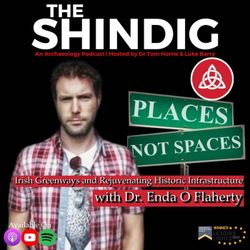
6. Irish Greenways and Rejuvenating Historic Infrastructures - With Dr. Enda O'Flaherty
56:44||Season 3, Ep. 6In this episode, our own Dr. Enda O Flaherty talks about heritage infrastructure preservation in Ireland, with a particular focus on the fascinating development of 'greenways', which can be defined as linear active-travel paths, parks, or areas of cultural interest that often incorporate historic (linear) infrastructure like defunct railway lines. We explore the challenges of balancing the needs of new and rejuvenated infrastructure with the heritage value of existing environments and delve into the impacts of infrastructure projects on rural Ireland and the potential of greenways to provide alternatives to car reliance. Importantly, Enda discusses the importance of the distinction of creating a culturally and historically resonant 'place' versus a mere 'space'.Watch The Video version of the Shindig on YouTube:https://www.youtube.com/playlist?list=PLt4Lz_ocPm7DQTJY8W9riTET_Zf66BWiVFollow us on X:Red River Archaeology: https://x.com/ArchaeologyRedRubicon Heritage Services: https://x.com/rubiconheritageFollow us on Instagram:Red River Archaeology: https://www.instagram.com/redriverarchaeology/Rubicon Heritage Services: https://www.instagram.com/rubicon_heritage/Like us on Facebook:Red River Archaeology: https://www.facebook.com/RedRiverArchaeologyRubicon Heritage Services: https://www.facebook.com/RubiconHeritageVisit our website:https://www.redriverarchaeology.com/
5. Exploring Ireland's Viking-Age Towns, with Dr. Rebecca Boyd
01:40:09||Season 3, Ep. 5In this episode, we talk to Dr. Rebecca Boyd about the fascinating topic of Viking-Age towns in Ireland, from how Vikings helped create the first urban settlements, to discovering the smells, sights and sounds of daily life within a home. For the big picture, we chat about Scandinavian-influenced urbanism across Viking-Age Ireland and Europe, but balance this with a focus on the microscopic patterns and cadences of life and work in Viking-Age town houses in towns like Dublin. The vital role of developer-led archaeology in the study of Viking-Age towns in Ireland is key to much of Rebecca's research and Rebecca's new book, Exploring Ireland's Viking-Age Towns: Houses and Homes, which is a brilliant exploration of towns and urban life and one we heartily recommend to all of our listeners!
4. Building a Broch - with the Caithness Broch Project
48:25||Season 3, Ep. 4In this episode, Dr. Tom talks with Kenneth and Kirsty from the Caithness Broch Project, a pioneering scheme to build a ‘broch’ – massive Iron-Age drystone towers concentrated in Caithness, northern Scotland – for the first time in 2,000 years.Brochs are the tallest prehistoric structures found in Britain or Ireland, with these ‘pinnacles of prehistoric Scottish architecture’ potentially reaching over 15m in height! Their use is not certain – community-centred domestic use seems most likely – but the monumental scale suggests they were built to impress and act as highly-visible centres of their farming communities.The challenge of building a broch in the modern day is huge, but the Project has now selected the perfect site for the Big Broch Build and its mission to ensure heritage-based regeneration of Caithness, a region facing massive depopulation and job losses, can now continue apace!